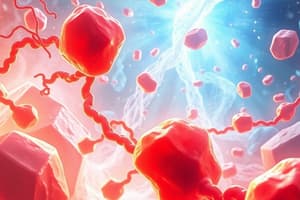Podcast
Questions and Answers
What is the function of apolipoproteins in lipoprotein metabolism?
What is the function of apolipoproteins in lipoprotein metabolism?
- To facilitate the transport of triglycerides and cholesterol (correct)
- To promote the aggregation of platelets
- To increase the production of thromboxane
- To decrease the risk of cardiovascular disease
What is the Omega (ω) numbering system used for?
What is the Omega (ω) numbering system used for?
- To identify the family of omega-3 fatty acids (correct)
- To calculate the molecular weight of a fatty acid
- To classify fatty acids based on their chain length
- To determine the number of double bonds in a fatty acid
What is the name of the fatty acid with the formula C16:0?
What is the name of the fatty acid with the formula C16:0?
- Palmitate (correct)
- Linoleic acid
- Arachidonic acid
- Linolenic acid
What is the effect of a diet high in omega-3 fatty acids on serum triglycerides?
What is the effect of a diet high in omega-3 fatty acids on serum triglycerides?
What is the order of lipoproteins in increasing density?
What is the order of lipoproteins in increasing density?
What is the main function of lipoproteins?
What is the main function of lipoproteins?
What is the name of the fatty acid with the formula C20:4 (5,8,11,14)?
What is the name of the fatty acid with the formula C20:4 (5,8,11,14)?
What is the purpose of omega-3 fatty acids in platelet membranes?
What is the purpose of omega-3 fatty acids in platelet membranes?
Flashcards are hidden until you start studying
Study Notes
Lipoproteins and Fatty Acids
- Fatty acids are long-chain carboxylic acids, with the carboxyl carbon as number 1 and the α carbon as number 2.
- Fatty acid nomenclature includes the number of carbons and double bonds (e.g., C16:0 for palmitate).
- Saturated fatty acids have no double bonds.
Omega Fatty Acids
- The omega (ω) numbering system is used to designate fatty acids (e.g., linoleic C18:2 (9,12) or 18Δ9,12 ω-6 family).
- Omega-3 fatty acids are correlated with a decreased risk of cardiovascular disease.
- Omega-3 fatty acids can replace arachidonic acid in platelet membranes, reducing thromboxane production and platelet aggregation.
Lipoprotein Metabolism
- Lipoproteins transport triglycerides and cholesterol in the blood.
- Lipoproteins are named according to their density, increasing with protein percentage:
- Chylomicrons (least dense)
- VLDL (very low-density lipoproteins)
- IDL (intermediate-density lipoproteins)
- LDL (low-density lipoproteins)
- HDL (high-density lipoproteins)
Studying That Suits You
Use AI to generate personalized quizzes and flashcards to suit your learning preferences.




